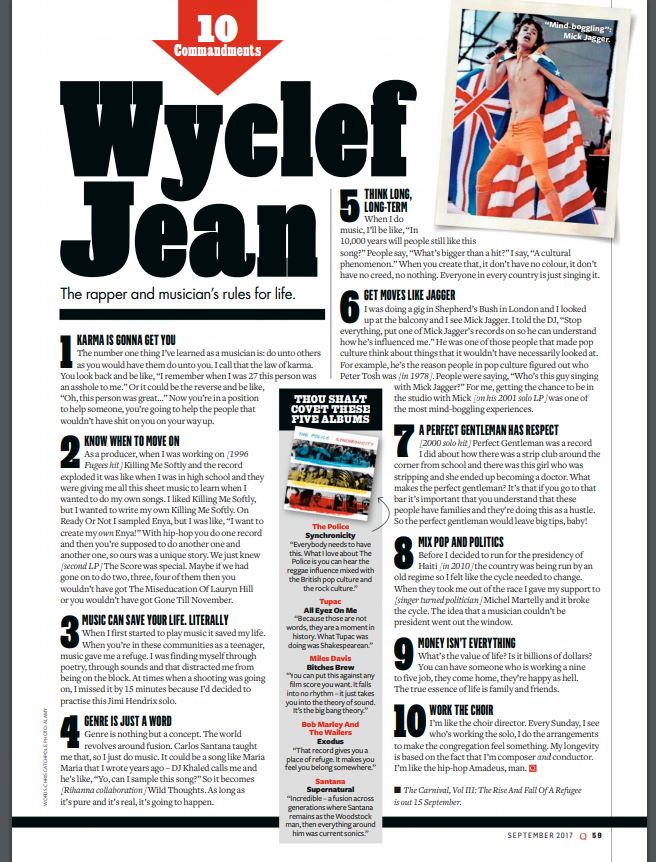This is my analysis of a double page spread from a published magazine. I will be unpicking how the journalist has represented the individual with the language and how this article follows the rules of AIDA (attract, interest, desire, action) and linking this in with Blumer and Katz uses and gratification theory.
Journalistic Reportage
- Who- Wyclef Jean
- What- “The rappers and musicians rules for life” in the stand first
- Where- An interview, most likely done in office
- When- September 2017
- Why- He is a popular rapper/musician with a positive view of life
- How- He is reveling all, states in the stand first
What’s this article about?
This article is an interview with the rapper/musician Wyclef Jean on his top 10 rules for life. The audience will learn his personal tips and his perspective on life. Thinking of the uses and gratification theory by Blumer and Katz this article will inform the audience and reinforce their personal identity if they follow any of these tips as he can be seen as a role model.
What’s my sense of this person that the Journalist is writing about?
When I read through the article and even just by looking at it I got a sense of who this person is, he comes across as calm, chill, wise and also I have the impression of fun and quite youthful as well as a respectable person. I’m going to analyze how this representation was achieved.
How do they represent the artist?
Firstly, the use of colloquial language within the headlines and sub heading for example the simile heading “Get moves like Jagger” is a cultural allusion to the popular song by Maroon 5, as well as referencing the famous Mick Jagger this makes him seem fun and also relatable to the audience. He also uses slang language which you can see with “Leave big tips, baby!” saying “baby” is very colloquial which again represent him as relatable, fun, youthful individual. Then we see this respectable side to him with the heading “A perfect gentlemen has respect” this creates a kind, perfect star image, with the noun “gentlemen” and adjective “respect”, which is very appealing for the audience. One of the stories he shares his hardship in his childhood/teen hood in tip number 3, sharing a personal experience presents him as human and can evoke emotion from the audience and represents him as authentic and not fake which is really appealing to an audience. There is also a section of his top 5 albums, which informs the reader on his personals likes and can create a connection and relatability to his readers if they perhaps like the same albums.
Conclusion
Overall, the journalist has captured a respectable, fun and relatable star to the audience with a very positive, optimistic tone throughout the article. It’s clear that the journalist thought about AIDA as the article really attracts and interests the reader through the use of quotes and the language used in the headings. And finally, the uses and gratification theory this article is evidently one to inform the audience as he is giving the reader tips for life, reinforce their personal identity by sharing personal stories and his favourite albums and finally some entertainment as well with some of the interesting stories he shares.
Thinking forward, I decided to do this analysis in order to understand what sort of language the journalists uses to represent the star so for when I start writing my own article I have an idea in what language to include to create a successful article. Furthermore, I also know that I must keep in mind AIDA and the gratification theory when designing my double page spread.

